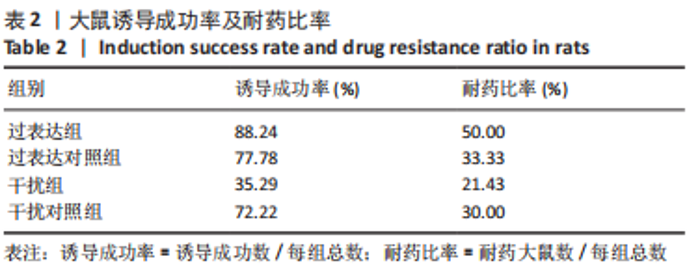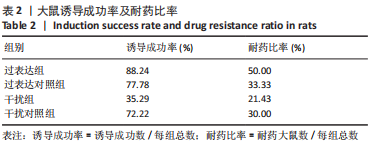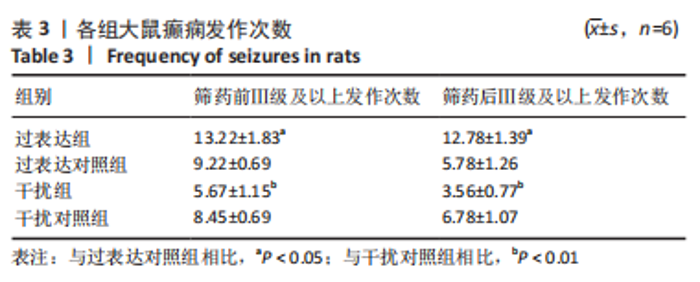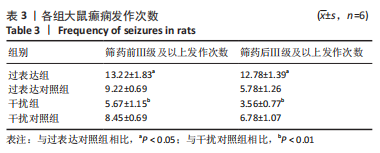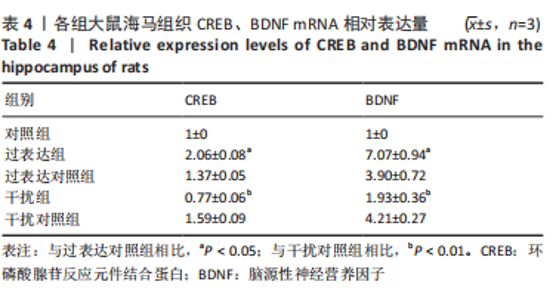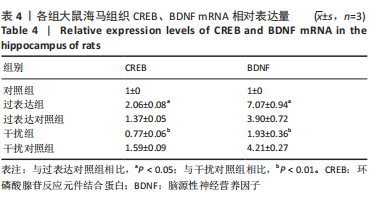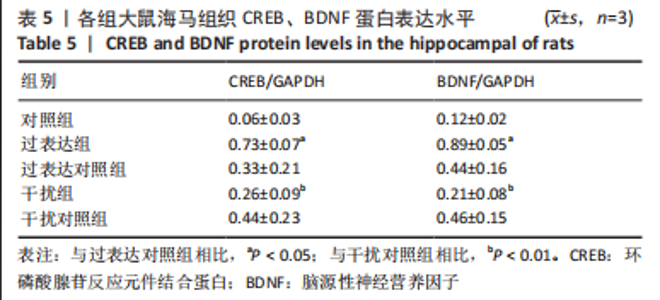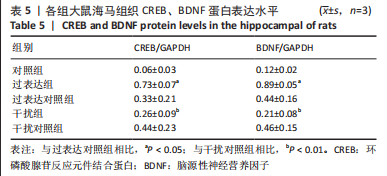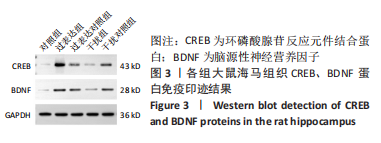Chinese Journal of Tissue Engineering Research ›› 2023, Vol. 27 ›› Issue (35): 5659-5664.doi: 10.12307/2023.847
Previous Articles Next Articles
Regulatory effects of cAMP response element-binding protein on hippocampal brain-derived neurotrophic factor level in a rat model of drug-resistant epilepsy
Li Jingxuan1, Shi Dai1, Wu Guofeng2
- 1Guizhou Medical University, Guiyang 550004, Guizhou Province, China; 2Affiliated Hospital of Guizhou Medical University, Guiyang 550004, Guizhou Province, China
-
Received:2022-10-20Accepted:2022-11-30Online:2023-12-18Published:2023-06-02 -
Contact:Wu Guofeng, MD, Professor, Chief physician, Affiliated Hospital of Guizhou Medical University, Guiyang 550004, Guizhou Province, China -
About author:Li Jingxuan, Master candidate, Guizhou Medical University, Guiyang 550004, Guizhou Province, China -
Supported by:National Natural Science Foundation of China (General Program), No. gyfynsfc-2021-8 (to WGF)
CLC Number:
Cite this article
Li Jingxuan, Shi Dai, Wu Guofeng. Regulatory effects of cAMP response element-binding protein on hippocampal brain-derived neurotrophic factor level in a rat model of drug-resistant epilepsy[J]. Chinese Journal of Tissue Engineering Research, 2023, 27(35): 5659-5664.
share this article
Add to citation manager EndNote|Reference Manager|ProCite|BibTeX|RefWorks

2.2 耐药性癫痫模型建立 注射过表达慢病毒的大鼠共有10只成为慢性癫痫模型,最终筛选出 5只耐药性癫痫大鼠,5只药物敏感性癫痫大鼠;注射过表达对照慢病毒的大鼠共9只成为慢性癫痫模型,最终筛选出3只耐药性癫痫大鼠,6只药物敏感性癫痫大鼠;注射干扰慢病毒的大鼠共14只成为慢性癫痫模型,最终筛选出3只耐药性癫痫大鼠,11只药物敏感性癫痫大鼠;注射干扰对照慢病毒的大鼠共10只成为慢性癫痫模型,最终筛选出3只耐药性癫痫大鼠,7只药物敏感性癫痫大鼠。结果分析,注射过表达慢病毒的大鼠耐药比率高于过表达对照组,而注射干扰慢病毒的大鼠耐药比率低于干扰对照组,见表2。 2.3 病毒注射结果 慢病毒转染后,镜下观察注射不同慢病毒大鼠的海马组织表达绿色荧光,提示各组大鼠慢病毒转染大鼠海马组织成功,慢病毒转染有效调控大鼠海马组织CREB表达,见图2。"
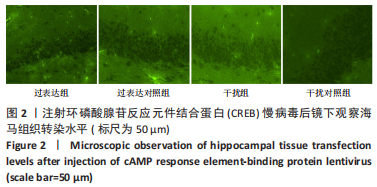
| [1] FALCO-WALTER JJ, SCHEFFER IE, FISHER RS. The new definition and classification of seizures and epilepsy. Epilepsy Res. 2018;139:73-79. [2] FISHER RS, ACEVEDO C, ARZIMANOGLOU A, et al. ILAE official report: a practical clinical definition of epilepsy. Epilepsia. 2014;55(4):475-482. [3] BERETTA S, CARONE D, ZANCHI C, et al. Long-term applicability of the new ILAE definition of epilepsy. Results from the PRO-LONG study. Epilepsia. 2017;58(9):1518-1523. [4] 陈佳,吴逊.难治性癫痫诊疗新思路[J].中华医学杂志,2010,90(9): 643-645. [5] CHOW J, JENSEN M, AMINI H, et al. Dissecting the genetic basis of comorbid epilepsy phenotypes in neurodevelopmental disorders. Genome Med. 2019;11(1):65. [6] KALILANI L, SUN X, PELGRIMS B, et al. The epidemiology of drug-resistant epilepsy: A systematic review and meta-analysis. Epilepsia. 2018;59(12):2179-2193. [7] KATYAYAN A, DIAZ-MEDINA G. Epilepsy: Epileptic Syndromes and Treatment. Neurol Clin. 2021;39(3):779-795. [8] YU J, SWIETEK B, PRODDUTUR A, et al. Dentate cannabinoid-sensitive interneurons undergo unique and selective strengthening of mutual synaptic inhibition in experimental epilepsy. Neurobiol Dis. 2016;89: 23-35. [9] BALESTRINI S, SISODIYA SM. Pharmacogenomics in epilepsy. Neurosci Lett. 2018;667:27-39. [10] ARAIN FM, BOYD KL, GALLAGHER MJ. Decreased viability and absence-like epilepsy in mice lacking or deficient in the GABAA receptor α1 subunit. Epilepsia. 2012;53(8):e161-e165. [11] RAOL YH, LUND IV, BANDYOPADHYAY S, et al. Enhancing GABA(A) receptor alpha 1 subunit levels in hippocampal dentate gyrus inhibits epilepsy development in an animal model of temporal lobe epilepsy. J Neurosci. 2006;26(44):11342-11346. [12] SAURA CA, CARDINAUX JR. Emerging Roles of CREB-Regulated Transcription Coactivators in Brain Physiology and Pathology. Trends Neurosci. 2017;40(12):720-733. [13] GUO J, WANG H, WANG Q, et al. Expression of p-CREB and activity-dependent miR-132 in temporal lobe epilepsy. Int J Clin Exp Med. 2014;7(5):1297-1306. [14] PULIMOOD NS, RODRIGUES WDS JUNIOR, ATKINSON DA, et al. The Role of CREB, SRF, and MEF2 in Activity-Dependent Neuronal Plasticity in the Visual Cortex. J Neurosci. 2017;37(28):6628-6637. [15] ZHU X, DUBEY D, BERMUDEZ C, et al. Suppressing cAMP response element-binding protein transcription shortens the duration of status epilepticus and decreases the number of spontaneous seizures in the pilocarpine model of epilepsy. Epilepsia. 2015;56(12):1870-1878. [16] IUGHETTI L, LUCACCIONI L, FUGETTO F, et al. Brain-derived neurotrophic factor and epilepsy: a systematic review. Neuropeptides. 2018;72:23-29. [17] SONG M, MARTINOWICH K, LEE FS. BDNF at the synapse: why location matters. Mol Psychiatry. 2017;22(10):1370-1375. [18] DIENI CV, PANICHI R, AIMONE JB, et al. Low excitatory innervation balances high intrinsic excitability of immature dentate neurons. Nat Commun. 2016;7:11313. [19] HEINRICH C, LÄHTEINEN S, SUZUKI F, et al. Increase in BDNF-mediated TrkB signaling promotes epileptogenesis in a mouse model of mesial temporal lobe epilepsy. Neurobiol Dis. 2011;42(1):35-47. [20] SHARMA P, KUMAR A, SINGH D. Dietary Flavonoids Interaction with CREB-BDNF Pathway: An Unconventional Approach for Comprehensive Management of Epilepsy. Curr Neuropharmacol. 2019;17(12):1158-1175. [21] RACINE RJ. Modification of seizure activity by electrical stimulation: cortical areas. Electroencephalogr Clin Neurophysiol. 1975;38(1):1-12. [22] SUTULA T, CASCINO G, CAVAZOS J, et al. Mossy fiber synaptic reorganization in the epileptic human temporal lobe. Ann Neurol. 1989;26(3):321-330. [23] LÖSCHER W, BRANDT C. High seizure frequency prior to antiepileptic treatment is a predictor of pharmacoresistant epilepsy in a rat model of temporal lobe epilepsy. Epilepsia. 2010;51(1):89-97. [24] ZHU X, HAN X, BLENDY JA, et al. Decreased CREB levels suppress epilepsy. Neurobiol Dis. 2012;45(1):253-263. [25] YU Y, JIANG J. COX-2/PGE2 axis regulates hippocampal BDNF/TrkB signaling via EP2 receptor after prolonged seizures. Epilepsia Open. 2020;5(3):418-431. [26] ZHANG H, KONG Q, WANG J, et al. Complex roles of cAMP-PKA-CREB signaling in cancer. Exp Hematol Oncol. 2020;9(1):32. [27] MCTAGUE A, HOWELL KB, CROSS JH, et al. The genetic landscape of the epileptic encephalopathies of infancy and childhood. Lancet Neurol. 2016;15(3):304-316. [28] WU G, LIU Z, WANG L, et al. Hippocampal Low-Frequency Stimulation Decreased cAMP Response Element-Binding Protein and Increased GABAA Receptor Subunit α1 in Amygdala-Kindled Pharmacoresistant Epileptic Rats. Neuropsychiatry. 2017;7(6):983-993. [29] MERTZ C, KRARUP S, JENSEN CD, et al. Aspects of cAMP Signaling in Epileptogenesis and Seizures and Its Potential as Drug Target. Neurochem Res. 2020;45(6):1247-1255. [30] LIN TW, HARWARD SC, HUANG YZ, et al. Targeting BDNF/TrkB pathways for preventing or suppressingbepilepsy. Neuropharmacology. 2020; 167:107734107734. [31] HU Y, RUSSEK SJ. BDNF and the diseased nervous system: a delicate balance between adaptive and pathological processes of gene regulation. Neurochem. 2008;105(1):1-17. [32] BINDER DK. The role of BDNF in epilepsy and other diseases of the mature nervous system. Adv Exp Med Biol. 2004;548:34-56. [33] BINDER DK, SCHARFMAN HE. Brain-derived neurotrophic factor. Growth Factors. 2004;22(3):123-131. [34] ESVALD EE, TUVIKENE J, SIRP A, et al. CREB Family Transcription Factors Are Major Mediators of BDNF Transcriptional Autoregulation in Cortical Neurons. Neurosci. 2020;40(7):1405-1426. [35] RAFA-ZABŁOCKA K, KREINER G, BAGIŃSKA M, et al. Selective Depletion of CREB in Serotonergic Neurons Affects the Upregulation of Brain-Derived Neurotrophic Factor Evoked by Chronic Fluoxetine Treatments. Front Neurosci. 2018;9(12):637-637. [36] FALCICCHIA C, PAOLONE G, EMERICH DF, et al. Seizure-Suppressant and Neuroprotective Effects of Encapsulated BDNF-Producing Cells in a Rat Model of Temporal Lobe Epilepsy. Mol Ther Methods Clin Dev. 2018;5(9):211-224. [37] LAI HC, CHANG QY, HSIEH CL. Signal Transduction Pathways of Acupuncture for Treating Some Nervous System Diseases. Evid Based Complement Alternat Med. 2019;2019:2909632. [38] YEH CM, HUANG CC, HSU KS. Prenatal stress alters hippocampal synaptic plasticity in young rat offspring through preventing the proteolytic conversion of pro-brain-derived neurotrophic factor (BDNF) to mature BDNF. J Physiol. 2012;590(4):991-1010. [39] KLEIN KM, PENDZIWIAT M, COHEN R, et al. Autosomal dominant epilepsy with auditory features: a new LGI1 family including a phenocopy with cortical dysplasia. Neurol. 2016;263(1):11-16. [40] GORSKI JA, ZEILER SR, TAMOWSKI S, et al. Brain-derived neurotrophic factor is required for the maintenance of cortical dendrites. J Neurosci. 2003;23(17):6856-6865. [41] LUCARINI N, VERROTTI A, NAPOLIONI V, et al. Genetic polymorphisms and idiopathic generalized epilepsies. Pediatr Neurol. 2007;37:157-164. |
| [1] | Liu Xinxin, Geng Zhizhong, Chen Jian. Effects of high-intensity interval training with different intervention durations on cognitive function in older adults: a Meta-analysis [J]. Chinese Journal of Tissue Engineering Research, 2024, 28(14): 2282-2289. |
| [2] | Ma Ruixin, Liu Pan, Zhang Qiong, Zeng Gaofeng, Zong Shaohui. Molecular mechanism of total flavonoids of hawthorn leaves regulating astrocytes to repair spinal cord injury [J]. Chinese Journal of Tissue Engineering Research, 2023, 27(33): 5327-5333. |
| [3] | Yang Yazhu, Du Juan, Qu Haifeng, Li Jianmin, Zhang Yuxin, Liu Junjie. Effect of ginsenoside Rg1 on learning and memory ability of brain aging mice induced by D-galactose [J]. Chinese Journal of Tissue Engineering Research, 2023, 27(28): 4487-4493. |
| [4] | An Hepeng, Liu Zhenteng, Li Lixin, Xu Yafang, Fan Guofeng. Effects of brain-derived neurotrophic factor on neuronal activity, pain, and related cytokines in rats with lumbar spinal stenosis [J]. Chinese Journal of Tissue Engineering Research, 2023, 27(26): 4120-4125. |
| [5] | Shui Xiaoping, Li Chunying, Li Mingjuan, Li Shunchang, Sun Junzhi, Su Quansheng. Effects of aerobic and resistance exercise on antioxidant stress index and brain-derived neurotrophic factor expression in the hippocampus of type 2 diabetic rats [J]. Chinese Journal of Tissue Engineering Research, 2023, 27(2): 264-269. |
| [6] | Shui Xiaoping, Li Chunying, Li Shunchang, Sun Junzhi, Su Quansheng . Effects of aerobic and resistance exercises on brain-derived neurotrophic factor, nuclear factor-kappa B and inflammatory cytokines in skeletal muscle of type II diabetic rats [J]. Chinese Journal of Tissue Engineering Research, 2022, 26(5): 669-675. |
| [7] | Huang Chuanjun, Zou Yu, Zhou Xiaoting, Zhu Yangqing, Qian Wei, Zhang Wei, Liu Xing. Transplantation of umbilical cord mesenchymal stem cells encapsulated in RADA16-BDNF hydrogel promotes neurological recovery in an intracerebral hemorrhage rat model [J]. Chinese Journal of Tissue Engineering Research, 2022, 26(4): 510-515. |
| [8] | Wang Yuxiang, Cui Chuanju, Li Yanling, Li Aifan. Effect of brain-derived neurotrophic factor modified human amniotic mesenchymal stem cell transplantation on cognitive function in Alzheimer’s disease rats [J]. Chinese Journal of Tissue Engineering Research, 2022, 26(13): 2045-2049. |
| [9] | Lu Yi, Deng Wenchong. Regulation and difference of different exercise styles on brain structure and cognitive function [J]. Chinese Journal of Tissue Engineering Research, 2021, 25(20): 3252-3258. |
| [10] | Shi Zhengliang, Zhang Hua, Fan Zhiyong, Ma Wei, Yuan He, Yang Bing. Nerve conduits of chitosan/polyvinyl alcohol with brain-derived neurotrophic factor microspheres for peripheral nerve defects in rats [J]. Chinese Journal of Tissue Engineering Research, 2021, 25(10): 1555-1559. |
| [11] | Zhang Jian, Chen Miao, Li Weixin, Ye Yichao, Xu Huiyou, Ma Ke, Chen Xuyi, Sun Hongtao, Zhang Sai. Collagen/heparin sulfate scaffolds loaded with brain-derived neurotrophic factor promote neurological and locomotor function recovery in rats after traumatic brain injury [J]. Chinese Journal of Tissue Engineering Research, 2020, 24(34): 5538-5544. |
| [12] | Du Xiaowen, Lin Dapeng, Tu Guanjun. S100A4 promotes differentiation of neural stem cells through up-regulation of brain-derived neurotrophic factor [J]. Chinese Journal of Tissue Engineering Research, 2020, 24(19): 3029-3034. |
| [13] | Guo Xiaozheng, Wang Xing. Improvement of cognitive function in older adults based on near-infrared spectroscopy [J]. Chinese Journal of Tissue Engineering Research, 2020, 24(11): 1790-1796. |
| [14] | Wang Qian, Liu Yi, Zhang Yu, Yang Yinxiang, Wang Zhaoyan, Zhang Leping, Luan Zuo . The secretion levels of various cytokines in human adipose mesenchymal stem cells under hypoxia [J]. Chinese Journal of Tissue Engineering Research, 2019, 23(29): 4681-4687. |
| [15] | Shi Jiang, Gao Shilun, Liu Jinduo, Gu Tianxiang, Shi Enyi. Bone marrow mesenchymal stem cell exosomes alleviate oxygen-glucose deprivation/reperfusion injury in hippocampal neurons [J]. Chinese Journal of Tissue Engineering Research, 2019, 23(21): 3316-3322. |
| Viewed | ||||||
|
Full text |
|
|||||
|
Abstract |
|
|||||
